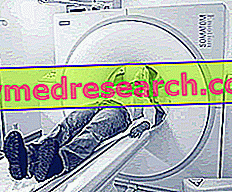TAC, which stands for computerized axial tomography, is a diagnostic technique that uses ionizing radiation to obtain detailed images of specific areas of the body.
However, the process by which these images are obtained is different from that of traditional radiology.

During a CT scan the electromagnetic radiation passes through the patient and is picked up by the detectors (small ionization chambers). In this way an electrical signal is obtained which, after being elaborated by very complicated algorithms, provides detailed images of the body. If necessary, these images can be reconstructed in a three-dimensional model.
In order to obtain detailed information on specific areas of the organism it is necessary to X-ray the section from multiple angles. The X-ray beam is thus projected following several different trajectories in succession.
For this reason the adjective "axial", referring to the beam projection along the plane of the same name, as it was in the first prototypes, is inappropriate because it is obsolete. Today it is precisely because of the transversality of the scans that we no longer speak of CT (computerized axial tomography) but of CT (computerized tomography). Given that the old term TAC is still used in common language we will continue to use, improperly, this old term for the rest of the article.
The equipment consists of a scanning unit called a gantry, a generator, the patient's bed, an electronic processor, a command console where the images are displayed and, finally, a system for recording the acquired data.
The TAC can be used without and with contrast medium.
The contrast media are substances that, introduced into the body (the routes of administration can be varied), absorb more or less intensely the X-rays compared to the tissues and the parenchymata, contrasting them artificially. Thanks to these contrast media it is possible, for example, to obtain detailed images of the intestinal lumen, vessels and brain, abdomen, thorax and pelvis.
In recent years the devices have evolved considerably and have given rise to new variants such as the multilayer CT and the spiral CT. The latter, in particular, allows the fast acquisition of images that are rather sharp and not very sensitive to cardiac and respiratory movements. The couch no longer moves only between one scan and another but is in continuous motion together with the x-ray tube and the dictators who make continuous propeller movements (spiral).
The multilayer CT represents a further evolution of the spiral CT. Thanks to this technique the human body is virtually "sliced" in many sub-millimeter layers (up to 160 per second) which, re-elaborated by the computer, provide three-dimensional images and indications on the functionality of the examined anatomical structure.
CT scan is particularly useful in the study of skeletal structures even if, for small joints (shoulder, elbow, wrist, hands, knee, foot), it is preferable to use MRI. The use of TAC becomes indispensable for analyzing fractures or their outcomes (for example, to assess the position of fracture fragments).
The CT scan is used to visualize the effects of head injuries with particular attention to the presence of possible bleeding.
The CT scan is often used in the oncology field and, thanks to recent developments, it is spreading more and more in the evaluation of body areas difficult to investigate such as blood vessels, bronchi, internal structures of the heart and the colon (the so-called virtual colonoscopy can be used in place of traditional colonoscopy).
How does it work?
When an X-ray beam passes through our body it is variously held back by the different anatomical structures. In particular, this bundle is the more attenuated the denser the structures crossed. By constructing an apparatus capable of capturing these differences it is possible to artificially reconstruct a detailed image of the section crossed.
The CT scan, unlike traditional radiography, makes use of a powerful mathematical processor that is able to evaluate even the slightest losses in the intensity of the beam, also differentiating structures with modest density differences.
EXECUTION OF THE EXAMINATION
Except for a few cases, such as virtual colonoscopy or CT with contrast media, no special preparations are required for the exam.
The patient is seated in the locker room and invited to remove the clothes from the area of the body to be investigated. The subject must also take care to remove any metal objects that could interfere with the test results (belts, rings, watches, etc.). Once the patient is ready, he is seated in the position required by the examination (supine, prone, lateral, etc.).
Just like a normal photo during the CT scan, body movements must be kept to a minimum to avoid getting blurred images. The patient will still receive appropriate instructions from the radiologist technician, such as the invitation to hold the breath several times for small intervals. If the patient is a child, the doctor may decide to give him a sedative to calm him and keep him immobile during the exam.
As the exam progresses, the couch advances small intervals through the scanner. The spiral CT instead foresees that during the scans the bed is in continuous movement. This modern technique has the great advantage of minimizing the examination time, and is able to scan the whole body in a few seconds.
Dangers and disadvantages of TAC
The X-rays projected by the equipment during the examination are not painful. The greatest discomfort for the patient derives from the need to remain motionless for a long time on the couch (for the spiral CT these times are reduced to a few tens of seconds or less).
If a CT scan with intravenous contrast medium is performed immediately after the injection, a slight local burning sensation, a hot flush and a metallic taste in the mouth may appear. These are common sensations that normally last only a few seconds. Contrast media is not harmful and can only trigger allergic reactions in rare cases. Even though it is very low, this risk is more concrete if the patient suffers from asthma, allergies or other pathological conditions such as diabetes and heart or thyroid problems.
The only problem is represented by ionizing radiations which, although administered at very low doses, are harmful to the body. During a certain or suspected pregnancy it is very important to communicate your condition to the doctor who may eventually decide to postpone the exam or choose an alternative diagnostic investigation.
For the same reason, when possible, we try to adopt other diagnostic tools that do not require the use of ionizing radiation such as ultrasound or MRI. Finally, remember that, unlike the latter, the CT scan can also be performed in the presence of internal pacemakers or defibrillators.



